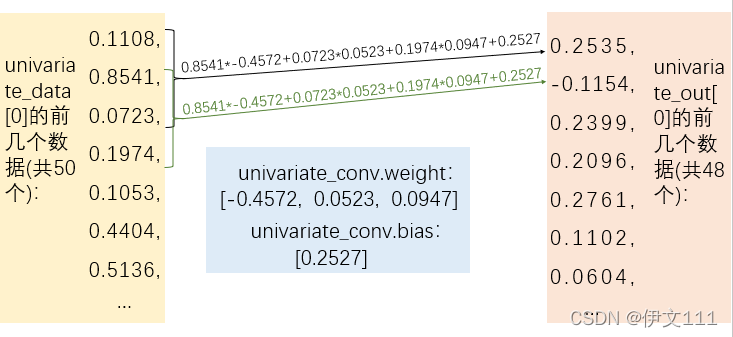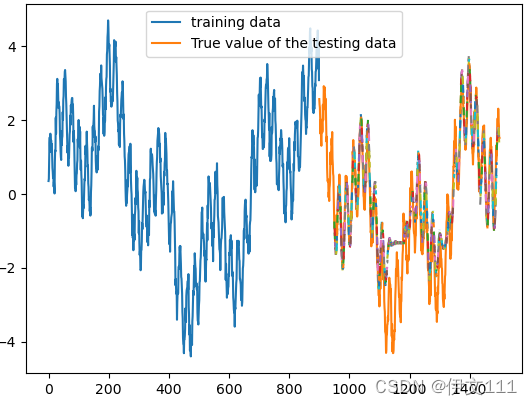网上对时序问题的代码详解很少,这里自己整理对CNN和RNN用于时序问题的代码部分记录,便于深入理解代码每步的操作。
本文中涉及的代码:https://github.com/EavanLi/CNN-RNN-TSF-a-toy
一、1D-CNN
1. Conv1d的接口
class torch.nn.Conv1d(in_channels, out_channels, kernel_size, stride=1, padding=0, dilation=1, groups=1, bias=True)
in_channels (int):输入通道数,在时间序列背景下即为输入序列的元数,或称为特征数。
out_channels (int):输出通道数,时序预测背景下单元预测单元/多元预测多元时out_channels和in_channels保持一致。
kernel_size (int or tuple):卷积核的尺寸;卷积核的第二个维度由in_channels决定,所以实际上卷积核的大小为kernel_size * in_channels
stride (int or tuple, optional) – 卷积操作的步长。 默认:1
padding (int or tuple, optional) – 输入数据各维度各边上要补齐0的层数。 默认: 0
dilation (int or tuple, optional) – 卷积核各元素之间的距离。 默认: 1
groups (int, optional) – 输入通道与输出通道之间相互隔离的连接的个数。 默认:1
bias (bool, optional) – 如果被置为True,向输出增加一个偏差量,此偏差是可学习参数。 默认:True
2. 输入数据shape介绍及应用卷积
(1)单元时序
- 输入数据shape介绍
举例:任意生成batch_size为5,长为50的单元时序数据。其中univariate_data.shape为torch.Size([5, 1, 50]),分别表示batch_size, 输入通道数/元数/特征数,时序长度。
univariate_data = torch.rand(5, 1, 50)
- 卷积构建并传入数据
举例:对单元预测单元来说,Conv1d的输入通道数和输出通道数均为1,以kernel size为3来说,构造卷积层并将数据传入。
univariate_conv = nn.Conv1d(in_channels=1, out_channels = 1, kernel_size = 3)
univariate_out = univariate_conv(univariate_data)
- 输出数据shape介绍
这里univariate_out的shape是torch.Size([5, 1, 48])。 - 以前几个数据的卷积操作为例,看下图解释其计算过程:

(2)多元预测多元
- 输入数据shape介绍
举例:任意生成batch_size为5,特征数为2且长为50的多元时序数据。其中univariate_data.shape为torch.Size([5, 2, 50]),分别表示batch_size, 输入通道数/元数/特征数,时序长度。
multivariate_data = torch.rand(5, 2, 50)
- 卷积构建并传入数据
举例:对多元预测多元来说,Conv1d的输入通道数和输出通道数均为特征数,以kernel size为3来说,构造卷积层并将数据传入。
multivariate_conv1 = nn.Conv1d(in_channels=2, out_channels = 2, kernel_size = 3)
multivariate_out = multivariate_conv1(multivariate_data)
- 输出数据shape介绍
这里multivariate_out的shape是torch.Size([5, 2, 48])。 - 以前几个数据的卷积操作为例,看下图解释其计算过程:

(3)多元预测单元
- 输入数据shape介绍
与多元预测多元相同
multivariate_data = torch.rand(5, 2, 50)
- 卷积构建并传入数据
举例:对多元预测单元来说,Conv1d的输入通道数为特征数,输出特征数为1,以kernel size为3来说,构造卷积层并将数据传入。
multivariate_conv = nn.Conv1d(in_channels=2, out_channels = 1, kernel_size = 3)
univariate_out = multivariate_conv(multivariate_data)
- 输出数据shape介绍
这里univariate_out的shape是torch.Size([5, 1, 48])。 - 以前几个数据的卷积操作为例,看下图解释其计算过程:

3. 1D-CNN的前馈过程
多元预测单元,长为50的历史数据,其特征数为2,预测未来30个时刻的数值,其代码如下:
input = torch.rand(5, 2, 50)
conv = nn.Conv1d(in_channels=2, out_channels = 1, kernel_size = 3)
pool = nn.MaxPool1d(2, 2)
linear = nn.Linear(24,30)
output = conv(input)# 结束后为torch.Size([5, 1, 48])
output = torch.relu(output) # 结束后为torch.Size([5, 1, 48])
output = pool(output)# 结束后为torch.Size([5, 1, 24])
output = linear(output) # 结束后为torch.Size([5, 1, 30])
预测结果查看(以上代码仅为卷积操作的一次前馈过程,卷积参数未经过训练,这个结果代码就是一个little toy):
plt.plot(input[0][0])
plt.plot(range(len(input[0][0]),len(input[0][0]) + len(output[0][0])),output[0][0].detach().numpy())
4. 1D-CNN的完整训练过程
以sinewave数据集为例,写出1维卷积的完整预测过程,并给出中间特征结果图。
#以下为数据生成、完整的训练和预测代码
# ------------------------------------ 完整的卷积预测,以单元预测单元为例,历史输入长为50,做三步预测 ------------------------------------
def series_to_supervised(data, input_length, output_length, drop=True):
supervised_x, supervised_y = [], []
for i in range(len(data)-input_length-output_length): # 多余的数据抛弃
supervised_x.append(data[i:i+input_length])
supervised_y.append(data[i + input_length: i + input_length + output_length])
return supervised_x, supervised_y
def sinewave(N, period, amplitude):
x1 = np.arange(0, N, 1)
frequency = 1/period
theta = 0
y = amplitude * np.sin(2 * np.pi * frequency * x1 + theta)
return y
np.random.seed(0)
# 生成sinewave数据
N = 1500
y1 = sinewave(N, 24, 1) # plt.plot(range(len(y1)), y1) 24指的是周期长度,1是震动幅度
y2 = sinewave(N, 168, 1.5) # plt.plot(range(len(y2)), y2)
y3 = sinewave(N, 672, 2) # plt.plot(range(len(y3)), y3)
y = y1 + y2 + y3 + np.random.normal(0, 0.2, N)#y = y1 + y2 + y3 + np.random.normal(0, 0.2, N)
y[672:] += 10 # 模拟从样本中间开始的突然变化
# 划分训练数据和测试数据
train_data = y[:int(len(y)*0.6)]
test_data = y[int(len(y)*0.6):]
# 转化为监督学习格式
input_length, output_length = 50, 3
train_x, train_y = series_to_supervised(train_data, input_length, output_length)
train_x, train_y = torch.Tensor(train_x), torch.Tensor(train_y)
train_x, train_y = train_x.resize(train_x.shape[0],1,train_x.shape[1]), train_y.resize(train_y.shape[0],1,train_y.shape[1])
test_x, test_y = series_to_supervised(test_data, input_length, output_length)
test_x, test_y = torch.Tensor(test_x), torch.Tensor(test_y)
test_x, test_y = test_x.resize(test_x.shape[0],1,test_x.shape[1]), test_y.resize(test_y.shape[0],1,test_y.shape[1])
# 搭建网络
class Model(nn.Module):
def __init__(self):
super().__init__()
self.conv = nn.Conv1d(1, 1, 3)
self.pool = nn.MaxPool1d(2, 2)
self.linear = nn.Linear(24, 3) # 根据当前tensor形状和预测步长确定
def forward(self,x):
x.requires_grad_()
output = self.conv(x)
output = torch.relu(output)
output= self.pool(output)
output = self.linear(output)
return output
CNN_model = Model()
criterion = nn.MSELoss()
optimizer = torch.optim.SGD(CNN_model.parameters(), lr=0.001, momentum=0.9, weight_decay=1e-4)
loss_record = [] #记录训练损失变化
# 训练网络
for epoch in range(700):
predict_y = CNN_model(train_x)
loss = criterion(predict_y, train_y)
print('loss:', loss.item())
loss_record.append(loss.item())
optimizer.zero_grad()
loss.backward()
optimizer.step()
# 进行测试
with torch.no_grad():
predict_test = CNN_model(test_x)
predict_test = predict_test.detach().numpy()
# 绘制测试结果
plt.plot(y[:int(len(y)*0.6)], label = 'training data') # 训练数据
plt.plot(range(len(y[:int(len(y)*0.6)]), len(y)), y[int(len(y)*0.6):], label = 'True value of the testing data') # 测试数据的真实值
for sample_No in range(len(predict_test)):
plt_range_min = sample_No+len(y[:int(len(y)*0.6)]) + input_length
plt_range_max = plt_range_min + output_length
plt.plot(range(plt_range_min,plt_range_max),predict_test[sample_No][0],'--') # 绘制预测结果
plt.legend()
plt.show()
下图结果图。相对来说,数据构成越复杂,有较大的跳跃/含噪声,预测结果越差。
























 2559
2559











 被折叠的 条评论
为什么被折叠?
被折叠的 条评论
为什么被折叠?








